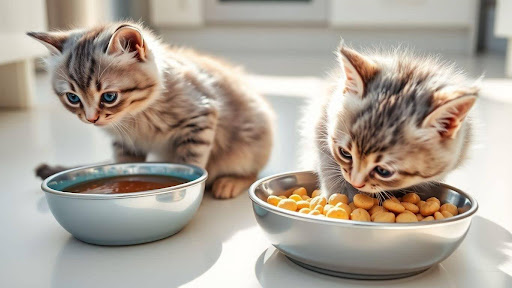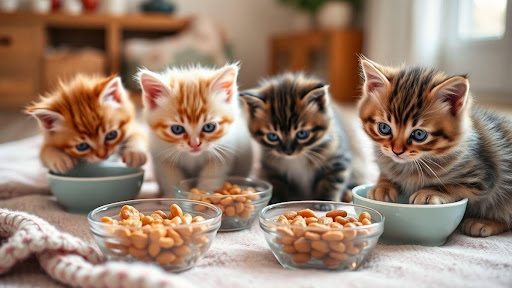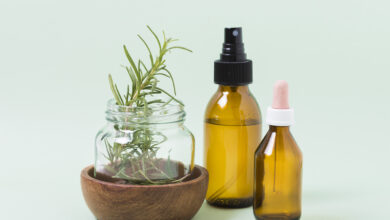Health and Nutrition Essentials for Growing British Kittens

Milestones in Early Kittenhood
British kittens grow fast and hit some big changes in their first few months. During the first week, kittens are tiny, with their eyes closed and almost no movement—but by week three, their eyes open, and their wobbly legs start getting stronger. Between four and eight weeks, they explore, play, and learn to use litter trays. By twelve weeks, most British kittens are playful, coordinated, and ready for more independence from mom.
Keeping an eye on these early milestones in a British kitten’s life helps owners make sure things are on track. If a kitten falls behind or seems much smaller than expected, it could mean there’s an issue that needs a vet’s attention. Slow growth, lack of energy, or problems moving usually aren’t just quirks—they’re signs to check in on health and nutrition.
One important thing: growth spurts can sneak up, so frequent weigh-ins (even with a kitchen scale) make it simple to spot steady kitten growth and development.
Signs of Healthy Growth
Owners should watch out for some clear, practical clues that a British kitten is thriving. A healthy kitten is steadily gaining weight, has a shiny coat, and shows lots of curiosity during its waking hours. Healthy kittens also have clear eyes, a clean nose, and alert ears. If you notice strong playfulness and regular eating, those are great signs, too.
On the flip side, be careful if a kitten’s ribs stand out or if its belly looks thin for long stretches—those are early hints that something in their kitten growth and development might be off. Consistent energy and strong social behavior usually mean their body and mind are growing at a good pace.
| Age (weeks) | Typical Weight (grams) | Major Development |
| 1 | 110 – 170 | Eyes/eat/sleep |
| 4 | 350 – 500 | Play/socialize |
| 8 | 800 – 1000 | Full mobility |
| 12 | 1200 – 1500 | High activity/teeth |
The Role of Nutrition in Development
Nutrition has a huge effect on how British kittens develop. In the early weeks, mother’s milk or kitten formula covers all their basic needs. As they start on solids, the right balance of protein, fats, and vitamins supports muscle and bone growth. Choosing high-quality kitten food designed for this life stage makes a real difference—adult cat food just isn’t going to cut it for growing kittens.
A few big reasons: protein builds tissue and muscle, fats give energy, and minerals like calcium help bones and teeth. Not paying attention to the specific needs of kitten growth and development can lead to weak bones, poor weight gain, and even long-term health issues.
In the end, British kittens need specific support at every stage to grow into strong, healthy adult cats. Carefully watching their progress and prioritizing the right nutrition keeps development steady and sets the groundwork for a healthy life.
Choosing the Best Nutrition for Young British Kittens
Young British kittens need the right food to grow strong and healthy. Choosing the best nutrition for young British kittens can make all the difference during those early months, so it’s worth taking the time to get every detail right.
Kitten-Specific Nutritional Requirements
Feeding kittens isn’t the same as feeding adult cats. Their growing bodies burn through energy at a fast rate, and they need more protein, calories, and certain vitamins. Kitten food is made to meet these needs. Look for formulas labeled ‘kitten’ or ‘growth’—these have a better balance of what’s needed for bones, muscles, and immune system support. Using the right formula helps young British kittens reach their potential.
Protein, Fats, and Essential Nutrients
Quality kitten foods are packed with animal-based proteins, healthy fats, and key nutrients like calcium, phosphorus, vitamin E, and DHA. Here’s a quick comparison of what’s required:
| Nutrient | Kitten Requirement |
| Protein | Over 30% (dry matter) |
| Fat | 15-20% |
| Calcium | 0.8–1.6% |
| Calories | 100–130 per kg body wt |
Protein grows muscles, fats fuel energy, and minerals strengthen bones. A diet with these parts in balance gets young British kittens off to a good start.
Dangers of Feeding Inappropriate Foods
Feeding young British kittens with inappropriate foods risks their health. Foods designed for adult cats, human snacks like chocolate, onions, garlic, and even some dairy can harm or upset a growing kitten’s system. They shouldn’t eat ‘all life stages’ foods unless specifically approved by a vet, since these don’t focus on kitten growth. Even well-meaning snacks can cause stomach problems or slow development, so it’s best to stick with nutrition made just for kittens.
It may seem easier to offer bits of your own meal or switch to adult cat food early, but this can actually hold your kitten back. Focus on nutrition for their age, and you’ll spare them from health issues later.
Choosing the best nutrition for young British kittens means being careful and selective from the start. With the right plan, a kitten’s future health looks much brighter.
Wet Versus Dry Food for British Kittens
When it comes to the health and development of British kittens, choosing between wet and dry food can make a big difference. Wet kitten food has a higher water content and is closer to a kitten’s natural diet, helping maintain hydration and keeping their urinary tract in better shape. On the other hand, dry food is easy to store and serve, but it usually contains more carbohydrates and far less moisture, which might not be ideal for growing kittens.
Benefits of High-Moisture Diets
Wet kitten food brings extra hydration into your kitten’s everyday meals. Since British kittens often don’t drink much water, this extra moisture is important. It helps reduce the risk of dehydration and supports overall urinary health. Plus, wet food usually comes in a range of flavors and textures, making mealtime more appealing for picky eaters.
Offering a high-moisture diet can help kittens stay hydrated and more energetic, especially during growth spurts.
Typical Protein and Carbohydrate Content
Here’s how wet and dry options stack up for British kittens:
| Food Type | Protein (%) | Carbohydrates (%) | Moisture (%) |
| Wet Food | 10-15 | 2-5 | 70-80 |
| Dry Food | 30-40 | 20-30 | 8-12 |
Wet food generally uses higher-quality proteins and keeps carbs low, while dry food often relies more on plant-based fillers. Feeding the right balance of nutrients leads to healthy muscles and sustained growth for British kittens.
Hydration Considerations for Growing Cats
Hydration plays a big role in the overall wellness of young cats. British kittens who eat mainly dry food may be prone to urinary issues if they aren’t getting enough water. Consider adding a wet meal to their routine if you see your kitten rarely visiting their water bowl. Automatic water fountains can help, but nothing beats the natural moisture found in wet kitten food for proper hydration.
- Wet food supports overall fluid intake.
- Dry food may need supplementary water.
- Hydration impacts kidney development and urinary health.
Overall, for British kittens, keeping their meals on the moist side often means fewer health headaches down the road. Wet kitten food, despite being pricier, is an investment in your kitten’s lifelong wellness.
Establishing Healthy Eating Habits from the Start
Helping young British kittens grow up healthy starts with making good choices about what and how they eat. Getting their food habits right now can shape their eating patterns for life. Owners need to think about things like varied diets, preventing picky eating, and making smooth transitions to solid food. Here’s what matters most for those early days:
Importance of Varied Diets and Texture
British kittens learn what food is long before they become adults. When their first meals include lots of textures—like soft pates, chunky stews, and small dry kibbles—they’re more open to eating different foods as they grow up. Introduce protein sources one at a time, so their stomachs can adjust. This makes British kittens less likely to reject new foods or textures as adults.
- Offer both wet and dry kitten foods
- Swap between chicken, fish, and lamb flavors over several weeks
- Gradually introduce new shapes and sizes of kibble
British kittens with wider food experiences early on don’t usually get bored with their meals, and this can cut down on feeding troubles later.
Risks of Picky Eating and How to Prevent It
Some kittens get fussy fast if they always eat the same thing. Picky eating can turn into a headache for everyone. The trick is to not let British kittens fall into a single-meal routine. Rotate their foods, but avoid quick, big changes in diet—this helps their tummies and minds adjust without stress.
- Don’t keep serving one brand or flavor for more than a week at a time.
- Watch for signs like sniffing and walking away—switch it up before it becomes a habit.
- Go slow: each time you want to try a new food, blend small amounts in with their usual food over 5-7 days.
If a British kitten shows signs of pickiness, staying patient and offering choices often leads to better feeding habits down the road.
Transitioning Kittens to Solid Foods
When it’s time to switch from mom’s milk or formula to solids, don’t rush. British kittens need time to figure out new foods. Start with soft, moist kitten food and gradually mix in more solid options over two weeks. Most kittens do best when about 10-20% of each meal is the new food at first, increasing a bit every couple of days.
| Day | New Food (%) | Old Food (%) |
| 1-3 | 10 | 90 |
| 4-6 | 30 | 70 |
| 7-9 | 50 | 50 |
| 10-12 | 75 | 25 |
| 13-14 | 100 | 0 |
Solid food isn’t just about nutrition—it helps strengthen chewing muscles and gets British kittens ready for grown-up meals. Make any changes slowly to help them avoid tummy upsets and build long-lasting healthy eating habits.
Establishing healthy eating habits from the start gives British kittens a huge head start. If their early meals are balanced and interesting, most kittens grow up without food drama.
Meal Frequency and Portion Guidelines
Finding the right meal frequency and portion guidelines is key for young British kittens. This stage is all about feeding routines, keeping an eye on your kitten’s appetite, and avoiding those easy mistakes that can creep in if you guess portions.
Recommended Feeding Schedules by Age
British kittens need more frequent meals than adult cats. Their tiny stomachs fill up fast, and they have loads of energy to burn. From weaning until six months old, feedings should be split into three to four small meals every day. After six months, most kittens are ready to move to a twice-daily schedule—just like grown-up cats.
| Age | Meals per Day | Notes |
| 0–6 months | 3–4 | Small, frequent meals crucial |
| 6–12 months | 2 | Switch to adult feeding pattern |
Keep mealtime regular, morning to evening, and try not to skip a meal. Sudden changes in meal frequency can throw your kitten off, making them fussy or leading to stomach upsets.
Portion Sizes for Different Stages
Every British kitten grows at their own pace, so exact meal size always depends on their weight, age, and activity. For early weeks, a kitten may eat as little as a spoonful at a time, but by six months, portions get bigger.
- For kittens under four months: about 100–130 calories per kg body weight per day
- Four to six months: slowly increase servings as your kitten grows
- Six to twelve months: match portion sizes to adult guidelines on food packaging, adjusting as needed
Meal frequency and portion guidelines double as an easy way to watch for signs of growth problems. Too little? They’ll be lethargic. Too much? You might see a round belly or slower play.
Signs of Underfeeding or Overfeeding
Getting meal frequency and portion guidelines right means knowing when something’s off:
- Underfeeding: visible ribs, always hungry, reduced energy
- Overfeeding: bloated belly, rapid weight gain, less eager to play
- Steady, healthy weight gain signals you’re on the right track
Watch your kitten’s body—changes in appearance or energy are often the first clues that portions need an adjustment.
Stick to these practical meal frequency and portion guidelines, and your British kitten will grow up strong and healthy.
Immune System and Brain Development Through Diet
Nutrients That Support Immunity
A healthy British kitten needs more than just calories—they need the right nutrients for a strong immune system. The best kitten diets always include vitamins E and C, which are known to support natural defenses. Another big one is zinc, which helps skin and coat health. If a kitten’s food lacks these, their immunity might not be up to scratch, so always check that a kitten’s food meets these needs. Kitten nutrition plays a direct role in how well their bodies fend off sickness.
- Vitamins E & C: Fortify immune function
- Zinc: Promotes healing and robust skin
- Taurine: Supports heart and immune health
Promoting Cognitive Health with Omega-3s
For kitten brains, DHA—an omega-3 fatty acid—makes a noticeable difference. DHA assists brain cells to connect properly during this fast-paced stage of life. Many top-rated kitten foods mention DHA right on the label, especially those with fish oil. British kittens learning to explore, play, and solve problems need steady Omega-3s in their meals. If you want a quick hint: look for salmon oil, anchovy oil, or clear DHA additives listed in the ingredients. Without these, a kitten’s cognitive growth can slow down.
Omega-3s don’t just help brains—they help eyes too.
Supplementing for Optimal Growth
Sometimes, a British kitten’s diet may need an extra boost—a little added vitamin or mineral can smooth over gaps. Supplements like brewer’s yeast (for B vitamins), or a kitten-focused multivitamin, are options owners sometimes use, but only if a vet agrees. Over-supplementing can actually harm rather than help, as kittens are very sensitive to dosage. The safest route is providing a balanced, complete kitten nutrition formula.
| Nutrient | Supports | Common Source |
| DHA (Omega-3) | Brain & eye development | Fish oil |
| Vitamin E | Immune system | Plant oils/seeds |
| Zinc | Healing, skin, immunity | Meat, supplements |
Healthy immune system and brain development are linked—when kittens have the right mix of nutrition, they’re ready to learn, play, and grow at their best pace.
Choosing Where to Purchase British Kittens Responsibly

Picking the right place to purchase British kittens responsibly is more than just a quick search online. The choices made at this step shape the kitten’s health, behavior, and future well-being. British kittens come with unique needs, so new owners must be sharp about where and how to get them. Here’s what to keep in mind:
Selecting Reputable Breeders
- Look for breeders who prioritize the health and temperament of their cats.
- Reputable breeders keep their facilities clean, socialized, and open for in-person visits.
- They never rush you. Instead, they answer your questions about British kittens, living conditions, and lineage.
A reputable breeder puts the welfare of the kittens before profit. They’ll ask you questions about your home, routines, and expectations because they want a good match. This signals trustworthiness and care that’s hard to fake.
Health Certifications and Documentation
- Ask for vaccination records, deworming schedules, and proof of health checks.
- Genuine breeders have documents from licensed vets, including breed verification and genetic screening.
- Avoid anyone who dodges paperwork or offers vague answers about medical history.
| Document Type | Should Include |
| Vaccination Records | Dates and types of vaccinations given |
| Vet Health Checks | Notes on health, parasite control, etc. |
| Pedigree Certification | Lineage and parental health status |
Nutrition Guidance From Trusted Sources
- Good breeders provide clear feeding instructions tailored to British kittens.
- They recommend quality kitten food and explain safe transition methods to new diets.
- They are informed about British kittens’ special nutrition needs—never generic advice, always breed-specific.
People who purchase British kittens responsibly report fewer health issues and a smoother transition at home. It’s all about knowledge, patience, and asking the right questions.
Conclusion
Raising a British kitten is a big job, but it’s also pretty rewarding. Getting their nutrition right in those early months sets them up for a healthy life. It’s not about fancy ingredients or complicated routines—just making sure they get enough protein, the right balance of vitamins and minerals, and plenty of water. Wet food can help with hydration, and kitten-specific formulas are made for their growing bodies. Remember, every kitten is a little different, so it’s smart to check in with your vet if you’re unsure about anything. With a bit of care and attention to their diet, your kitten will be well on their way to becoming a strong, happy adult cat. Enjoy the journey—those tiny paws grow up fast!



